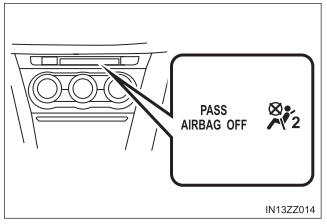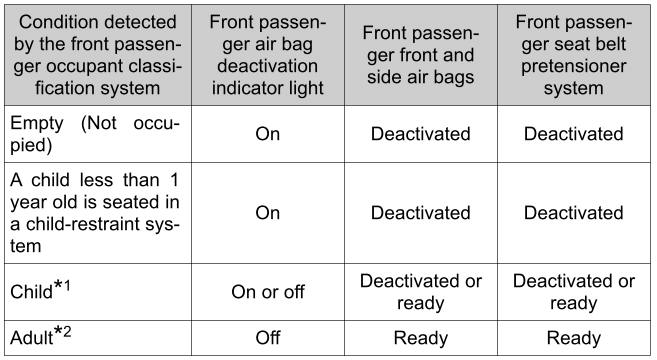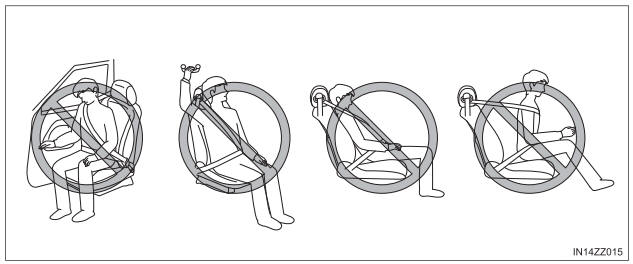Toyota Yaris: Front Passenger Occupant Classification System / Front Passenger Occupant Classification Sensor
Your vehicle is equipped with a front passenger occupant classification sensor as a part of the supplemental restraint system. This sensor is equipped in the front passenger’s seat cushion. This sensor measures the electrostatic capacity of the front passenger’s seat. The SAS unit is designed to prevent the front passenger front and side air bags and seat belt pretensioner system from deploying if the front passenger air bag deactivation indicator light turns on.
To reduce the chance of injuries caused by deployment of the front passenger air bag, the system deactivates the front passenger front and side air bags and also the seat belt pretensioner system when the front passenger air bag deactivation indicator light turns on. Refer to the following table for the front passenger air bag deactivation indicator light illumination conditions.
This system shuts off the front passenger front and side air bags and seat belt pretensioner system, so make sure the front passenger air bag deactivation indicator light turns on according to the following table.
The air bag/front seat belt pretensioner system warning light flashes and the front passenger air bag deactivation indicator light illuminates if the sensors have a possible malfunction. If this happens, the front passenger front and side air bags and seat belt pretensioner system will not deploy.
Front passenger air bag deactivation indicator light
This indicator light turns on to remind you that the front passenger front and side air bags and seat belt pretensioner will not deploy during a collision.

If the front passenger occupant classification sensor is normal, the indicator light turns on when the ignition is switched ON. The light turns off after a few seconds. Then, the indicator light turns on or is off under the following conditions:
Front passenger air bag deactivation indicator light on/off condition chart

* 1: The occupant classification sensor may not detect a child seated on the seat, in a child-restraint system, or a junior seat depending on the child’s physical size and seated posture.
* 2: If a smaller adult sits on the front passenger seat, the sensors might detect the person as being a child depending on the person’s physique.
The curtain air bag is ready for inflating regardless of what the front passenger air bag deactivation indicator light on/off condition chart indicates.
If the front passenger air bag deactivation indicator light does not turn on when the ignition is switched ON and does not turn on as indicated in the front passenger air bag deactivation indicator light on/off condition chart, do not allow an occupant to sit in the front passenger seat and consult your Toyota dealer as soon as possible. The system may not work properly in an accident.
- The system requires about 10 seconds to alternate between turning the front passenger front and side air bags and seat belt pretensioner system on or off.
- The front passenger air bag deactivation indicator light may turn on repeat- edly if luggage or other items are put on the front passenger seat, or if the temperature of the vehicle’s interior changes suddenly.
- The front passenger air bag deactivation indicator light may turn on for 10 seconds if the electrostatic capacity on the front passenger seat changes.
- The air bag/front seat belt pretensioner system warning light might turn on if the front passenger seat receives a severe impact.
- If the front passenger air bag deactivation indicator light does not turn on after installing a child-restraint system on the front passenger seat, first, reinstall your child-restraint system according to the procedure in this owner’s manual. Then, if the front passenger air bag deactivation indicator light still does not turn on, install the child-restraint system on the rear seat and consult your Toyota dealer as soon as possible.
- If the front passenger air bag deactivation indicator light turns on when an occupant is seated directly in the front passenger seat, have the passenger re-adjust their posture by sitting with their feet on the floor, and then re-fastening the seat belt. If the front passenger air bag deactivation indicator light remains turned on, move the passenger to the rear seat. If sitting in the rear seat is not possible, slide the front passenger seat as far back as possible. Consult your Toyota dealer as soon as possible.
WARNING
Do not allow an occupant in the front passenger’s seat to sit with a posture which makes it difficult for the front passenger occupant classification sensor to detect the occupant correctly
Sitting in the front passenger’s seat with a posture which makes it difficult for the front passenger occupant classification sensor to detect the occupant correctly is dangerous. If the front passenger occupant classification sensor cannot detect the occupant sitting on the front passenger’s seat correctly, the front passenger front and side air bags and pretensioner system may not operate (deploy) or they may operate (deploy) accidentally. The front passenger will not have the supplementary protection of the air bags or the accidental operation (deployment) of the air bags could result in serious injury or death. Under the following conditions, the front passenger occupant classification sensor cannot detect a passenger sitting on the front passenger’s seat correctly and the deployment/non-deployment of the air bags cannot be controlled as indicated in the front passenger air bag deactivation indicator light on/off condition chart. For example:
- A front passenger is seated as shown in the following figure:

- A rear passenger pushes up on the front passenger seat with their feet.
- Luggage or other items placed under the front passenger seat or between the front passenger seat and driver seat that push up the front passenger seat bottom.
- An object, such as a seat cushion, is put on the front passenger’s seat or between the passenger’s back and the seatback.
Do not allow an occupant in the front passenger’s seat to sit with a posture which makes it difficult for the front passenger occupant classification sensor to detect the occupant correctly
- A seat cover is put on the front passenger’s seat.
- Luggage or other items are placed on the seat with the child in the child-restraint system.
- A rear passenger or luggage push or pull down on the front passenger seatback.
- Luggage or other items are placed on the seatback or hung on the head restraint.
- The seat is washed.
- Liquids are spilled on the seat.
- The front passenger seat is moved backward, pushing into luggage or other items placed behind it.
- The front passenger seatback contacts the rear seat.
- Luggage or other items are placed between the front passenger seat and driver seat.
- An electric device is put on the front passenger’s seat.
- An additional electrical device, such as a seat warmer is installed to the surface of the front passenger seat.
The front passenger front and side air bags and seat belt pretensioner systems will deactivate if the front passenger air bag deactivation indicator light turns on.
NOTICE
- To assure proper deployment of the front air bag and to prevent
damage to
the sensor in the front seat cushion:
- Do not place sharp objects on the front seat cushion or leave heavy luggage on them.
- Do not spill any liquids on the front seats or under the front seats.
- To allow the sensors to function properly, always perform the
following:
- Adjust the front seats as far back as possible and always sit upright against the seatbacks with seat belts worn properly.
- If you place your child on the front passenger seat, secure the child-restraint system properly and slide the front passenger seat as far back as possible
 Constant Monitoring
Constant Monitoring
The following components of the air bag systems are monitored by a
diagnostic system:
Crash sensors, and diagnostic module (SAS unit)
Front air bag sensors
Air bag modules
Side crash sensors
Air bag/Front seat belt pretensioner system warning light
Front seat belt pretensioners
Related wiring
Front passenger air bag deactivation indicator light
Front passenger occupant classification sensor
Front passenger occupant classification module
The diagnostic module continuously monitors the system’s readiness...
Other information:
Toyota Yaris XP210 (2020-2026) Reapir and Service Manual: Antenna Coil Circuit Voltage Out of Range (B27841C)
DESCRIPTION When an open or short circuit is detected in the transponder key amplifier coil built into the engine switch, the certification ECU (smart key ECU assembly) stores this DTC. This DTC is also stored as a history DTC. DTC No. Detection Item DTC Detection Condition Trouble Area Note B27841C Antenna Coil Circuit Voltage Out of Range The transponder key amplifier coil built into the engine switch is open (see below) or shorted (determined by communication with certification ECU (smart key ECU assembly))...
Toyota Yaris XP210 (2020-2026) Reapir and Service Manual: Front Door Courtesy Switch
ComponentsCOMPONENTS ILLUSTRATION *1 FRONT DOOR COURTESY LIGHT SWITCH ASSEMBLY - - N*m (kgf*cm, ft.*lbf): Specified torque - - RemovalREMOVAL CAUTION / NOTICE / HINT HINT: Use the same procedure for the RH side and LH side...
Categories
- Manuals Home
- Toyota Yaris Owners Manual
- Toyota Yaris Service Manual
- Opening and Closing the Liftgate/Trunk Lid
- Adjustment
- Removal
- New on site
- Most important about car
Turning the Engine Off
Stop the vehicle completely. Manual transaxle: Shift into neutral and set the parking brake.Automatic transaxle: Shift the selector lever to the P position and set the parking brake.
Press the push button start to turn off the engine. The ignition position is off.
